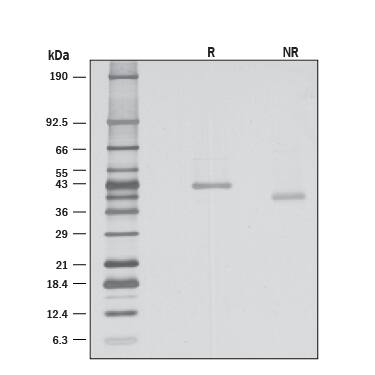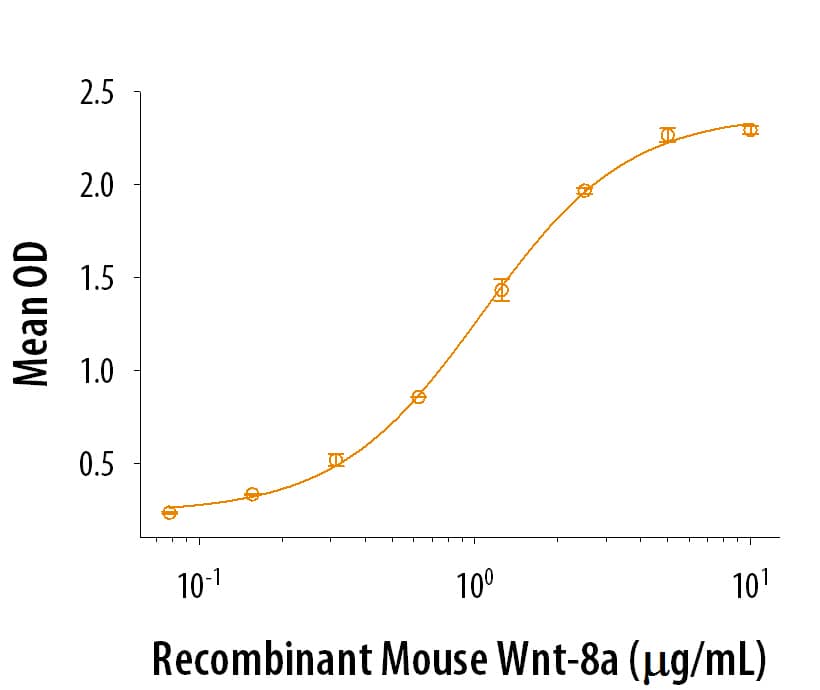Recombinant Mouse Wnt-8a Protein
R&D Systems, part of Bio-Techne | Catalog # 8419-WN

Key Product Details
Product Specifications
Source
Ala20-Trp354
Purity
Endotoxin Level
N-terminal Sequence Analysis
Predicted Molecular Mass
SDS-PAGE
Activity
The ED50 for this effect is 0.5-2.5 μg/mL.
Scientific Data Images for Recombinant Mouse Wnt-8a Protein
Wnt-8a Induces the Production of Alkaline Phosphatase.
Recombinant Mouse Wnt-8a stimulates alkaline phosphatase production by C3H10T1/2 mouse embryonic fibroblast cells. The ED50 for this effect is 0.5-2.5 μg/mL.Wnt-8a Induces the Production of Alkaline Phosphatase.
1 μg/lane of Recombinant Mouse Wnt-8a (Catalog # 8419-WN) was resolved with SDS-PAGE under reducing (R) and non-reducing (NR) conditions and visualized by silver staining, showing bands at 42.3 and 38.9 kDa, respectively.Formulation, Preparation and Storage
Carrier Free
What does CF mean?CF stands for Carrier Free (CF). We typically add Bovine Serum Albumin (BSA) as a carrier protein to our recombinant proteins. Adding a carrier protein enhances protein stability, increases shelf-life, and allows the recombinant protein to be stored at a more dilute concentration. The carrier free version does not contain BSA.
What formulation is right for me?In general, we advise purchasing the recombinant protein with BSA for use in cell or tissue culture, or as an ELISA standard. In contrast, the carrier free protein is recommended for applications, in which the presence of BSA could interfere.
Carrier: 8419-WN
| Formulation | Lyophilized from a 0.2 μm filtered solution in PBS, NaCl, EDTA and CHAPS with BSA as a carrier protein. |
| Reconstitution | Reconstitute at 100 μg/mL in PBS containing at least 0.1% human or bovine serum albumin. |
| Shipping | The product is shipped with polar packs. Upon receipt, store it immediately at the temperature recommended below. |
| Stability & Storage | Use a manual defrost freezer and avoid repeated freeze-thaw cycles.
|
Carrier Free: 8419-WN/CF
| Formulation | Lyophilized from a 0.2 μm filtered solution in PBS, NaCl, EDTA and CHAPS. |
| Reconstitution | Reconstitute at 100 μg/mL in PBS. |
| Shipping | The product is shipped with polar packs. Upon receipt, store it immediately at the temperature recommended below. |
| Stability & Storage | Use a manual defrost freezer and avoid repeated freeze-thaw cycles.
|
Background: Wnt-8a
Wnt-8a is a member of the large and highly conserved Wnt family of signaling molecules that have roles in pattern formation, cell fate decision, axon guidance, and tumor formation (1). Mouse Wnt-8a consists of a 19 amino acid (aa) signal peptide that is cleaved to release the mature 335 aa secreted protein (2). Mature mouse Wnt-8a shares 82% and 91% sequence identity with human and rat mature Wnt-8a, respectively. Similar to other canonical Wnts, Wnt-8a binds to the Frizzled family of receptors to intiate beta-catenin signaling. Wnt-8a is expressed during early embryogenesis and is involved in mesoderm patterning and posteriorization of the neuroectoderm (3-6). Wnt-8a signaling promotes optic lens development as well as otic placode formation during inner ear development (7, 8). Expression of Wnt-8a is observed in heart progenitor cells where it positively regulates cardiac myogenesis (9, 10).
References
- Anastas, J.N. and R.T. Moon (2013) Nat. Rev. Cancer 13:11.
- Bouillet, P. et al. (1996) Mech. Dev. 58:141.
- Rhinn, M. et al. (2005) Development 132:1261.
- Lekven, A.C. et al. (2001) Dev. Cell. 1:103.
- Erter, C.E. et al. (2001) Development 128:3571.
- Stump, R.J. et al. (2003) Dev. Biol. 259:48.
- Vendrell, V. et al. (2013) Mech. Dev. 130:160.
- Chong, C.C. et al. (2009) Exp. Eye Res. 88:307.
- Nakamura, T. et al. (2003) Proc. Natl. Acad. Sci. USA 100:5834.
- Kwon, C. et al. (2007) Proc. Natl. Acad. Sci. USA 104:10894.
Long Name
Alternate Names
Gene Symbol
UniProt
Additional Wnt-8a Products
Product Documents for Recombinant Mouse Wnt-8a Protein
Product Specific Notices for Recombinant Mouse Wnt-8a Protein
For research use only

